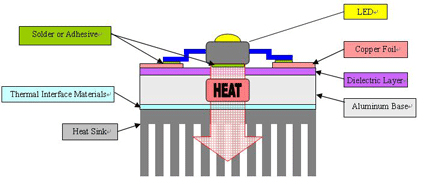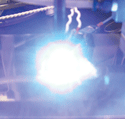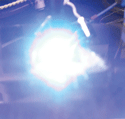■ LED
Light Emitting Diodes (LEDs) have been around for years, primarily concentrated in such markets as cell phones, PDAs and other consumer electronics. Since most of these products have relatively short lifecycles, protecting LEDs wasn’t a primary concern because the product would fail or become obsolete long before the LED failed. Today as technological advancements in LED design and processes are continually boosting light output to rival incandescent, fluorescent, and even halogen light sources.
Liking other electronic devices, heat is also the biggest threat to power LED. The LEDs color or wavelength will change with temperature. As the die temperature increases, the wavelength of the color increases. This is particularly important with white light. The human eye can differentiate small color changes in white light. Heat not only affects the light output of LED but also changes the color of light, and fails finally. The need to protect the LEDs against heat build-up is greater than ever before. One of the most efficient thermal solutions is Insulated Metal Substrates (IMS).
 The Power LEDs light output and life expectancy are directly attributed to how well the LED is managed thermally. As the LED generates heat, the dielectric of the insulated metal substrate quickly transfers it to the aluminum base, significantly improving the LEDs performance. While, most of the other manufacturers use standard prepreg as the dielectric layer, but preperg doesn’t provide the high thermal conductivity and results heat building up, then the LED will fail at last. So, the proper IMS board is rather important to power LED lighting. As the metal characters, IMS board can be designed to various shapes. Actually, the high thermal conductivity of IMS board makes the designers use the power LED in any application.
In order to show directly or simply, we do a comparison test to show how much influence to light output brought by different IMS boards with different thermal conductivities. The test precondition is: same power LED (1W), different IMS boards with different thermal conductivities, maintain the same die temperature of LED at 50°C, three different kinds of dielectric layers, and then compare the light output.
 |
 |
 |
| ◆Dielectric Materials: FR-4 Dielectric
◆Thermal Conductivity :. 0.3W/m-K |
◆Dielectric Materials: MP Dielectric
◆Thermal Conductivity :. 1.3W/m-K |
◆Dielectric Materials: LTI Dielectric
◆Thermal Conductivity : 2.2W/m-K |
Some latest famous known high power LED, like Cree® XLamp® XP-E and Lumileds™ Luxeon® Rebel, their solder size are reduced to 20% than ever before. In this situation, only IMS boards with efficient thermal conductivity can be qualified. Bergquist T-Clad and Beijing RuiKai LED-0602 have been widely used by many famous companies and OEMs, and also been proved rather reliable and efficient via long-term practice.
■ Motor rotation rate control
Industrial motor controller, variable speed device
■ Automobile, motorcycle
Voltage regulator, igniter, safety self-controlling system and lamp light control system
■ Audio
Output amplifier, equalizer amplifier, preamplifier
■ Electronics
Solid state relay, transistor base and element in various circuits
■ Others
large-scale substrate and aviation and military devices applied in case that the ceramic substrate is unqualified
|

